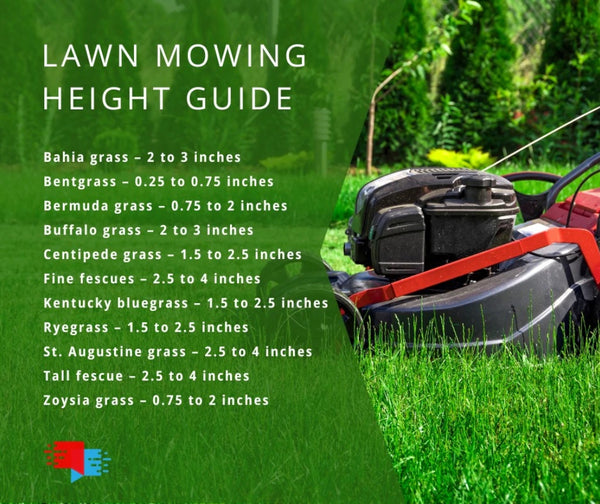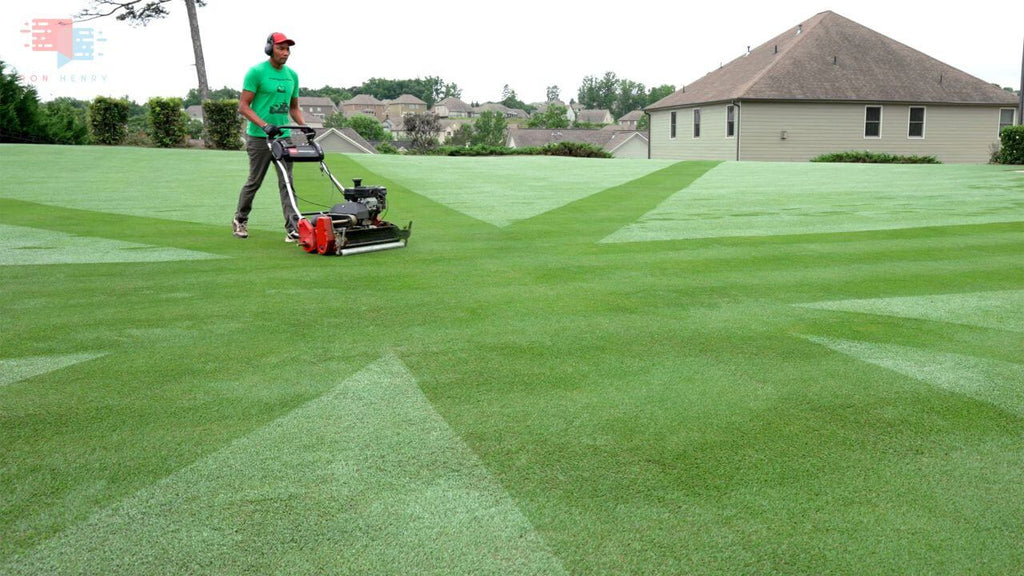Mowing Mastery: Best Practices for Spring Lawn Maintenance
Springtime promises rejuvenation and growth, and for lawn enthusiasts, it marks the beginning of the annual quest for the perfect lawn. As the sun's warmth returns and the days lengthen, our lawns awaken from their winter slumber, ready to burst forth with lush greenery. However, achieving that picture-perfect lawn requires more than just wishful thinking; it demands careful attention and proper maintenance.
When it comes to spring lawn maintenance, one aspect often overlooked is the art of mowing. While it may seem like a mundane chore to some folks, mastering the art of mowing is crucial for nurturing a healthy and vibrant lawn. Mowing keeps our lawns looking neat and tidy and plays a significant role in promoting strong root growth, preventing weed infestation, and enhancing overall lawn health. Not only that, a well-manicured lawn is a sign of respect for your neighborhood and community.
So, get your mower ready and join us as we unlock the secrets of mowing mastery and how to achieve lawn perfection this spring season.
Understanding Your Lawns Needs
To master mowing, you must first understand your lawn's needs. Lawns are not one-size-fits-all; they come in various shapes, sizes, and grass species, each with its own set of requirements and preferences.
1. Grass Types
Before diving into mowing techniques, take the time to identify the type of grass that blankets your lawn. Common grass species include Kentucky Bluegrass, Perennial Ryegrass, Tall Fescue, and Bermuda grass, among others. Each species has its own growth habits, tolerance levels, and ideal mowing heights. Knowing which type of grass you have, you can tailor your mowing regimen to suit its specific needs.
2. Grass Cutting Heights
Grass cutting heights play a pivotal role in maintaining a healthy lawn. Cutting grass too short can weaken the root system, making it more susceptible to drought, disease, and weed infestation. Conversely, allowing grass to grow too long can create a haven for pests and inhibit air circulation, leading to fungal issues.
As a general rule of thumb, aim to mow your lawn at a height corresponding to the recommended cutting height for your grass species. For cool-season grasses like Kentucky Bluegrass and Perennial Ryegrass, a cutting height of 1.5 to 2.5 inches is typically ideal. Warm-season grasses such as Bermuda grass and Zoysia grass fare better when mowed slightly shorter, usually between 0.75 to 2 inches. If you use a gas-powered reel mower, you’ll likely be able to cut even shorter, as low as 0.5 inches, on Bermuda and Zoysia grass.
3. The "One-Third Rule"
Adhering to the "one-third rule" is another cornerstone of successful lawn mowing. Outside of scalping your lawn, this rule dictates that you should avoid removing more than one-third of the grass blade's height in a single mowing session. Following this guideline ensures that your lawn retains enough leaf surface to photosynthesize and maintain healthy growth.
Regularly mowing your lawn to keep it within the recommended height range promotes a lush, uniform appearance and encourages the development of a robust root system. Additionally, maintaining consistent mowing heights reduces stress on the grass and minimizes the risk of scalping, particularly on uneven terrain.
By understanding your lawn's specific requirements and adopting appropriate mowing practices, you lay the foundation for a thriving and resilient turf.
Mowing Techniques

Mowing isn't just about cutting grass; it's about nurturing your lawn's health and vitality. By using proper mowing techniques, you can promote vigorous growth, minimize stress on the grass, and achieve that coveted manicured look. Let's explore some essential mowing practices to elevate your lawn care game this spring:
1. Sharp Blades, Clean Cuts
One of the cardinal rules of mowing mastery is ensuring your mower blades are sharp and in top condition. Dull blades tear grass rather than cleanly cutting it, leaving jagged edges more prone to disease and dehydration. Before each mowing session, take a moment to inspect your mower blades and sharpen them if necessary. Sharp blades make for clean cuts, resulting in healthier grass and a more aesthetically pleasing lawn.
If you use a reel mower, you’ll want to backlap your blades, which involves using a compound grit and spinning your reel blades backward to sharpen them. We’ll talk more about that later in the article.
2. Mowing Frequency
Springtime is synonymous with rapid grass growth, necessitating more frequent mowing sessions. However, it's essential to balance maintaining a manicured appearance and avoiding overzealous mowing. Aim to mow your lawn often enough to prevent it from becoming overgrown.
The ideal mowing frequency will vary depending on grass species, weather conditions, and soil fertility. Mowing frequency is also dictated by the height of cut. As a general rule, the lower you go, the more frequently you have to mow.
Plan to mow your lawn every four to seven days during the peak growing season. But if you are anything like us here at Golf Course Lawn, when the conditions are just right, you’ll mow every two or three days. Adjust the frequency as needed based on grass growth rates and visual cues from your lawn.
Plant growth regulators can also be used to slow down how quickly your grass grows.
3. Proper Mowing Height
As mentioned above, choosing the correct mowing height is crucial for maintaining a healthy lawn. Cutting grass too short weakens the root system and makes it more susceptible to drought, pests, and disease. Conversely, allowing grass to grow too tall can lead to a thatch buildup and untidy appearance.
Refer to our recommended mowing height guide for your specific grass species and adjust your mower accordingly. Avoid the temptation to scalp the lawn (when you don’t intend to) by setting the mower cutting height too low, as this can cause stress and damage to the grass. Instead, as we said earlier, aim to remove no more than one-third of the grass blade's height in a single mowing session, maintaining a consistent and uniform appearance across the lawn.

4. Mowing Patterns
Variety is the spice of life, and the same holds true for mowing patterns. While it may be tempting to follow the same mowing pattern week after week, alternating your mowing direction helps prevent soil compaction and encourages more upright grass growth. Experiment with different patterns, such as diagonal, crisscross, or circular mowing, to promote a healthier and more resilient lawn.
By incorporating these spring mowing tips into your lawn maintenance routine, you'll be well on your way to achieving mowing mastery.

Related: When to Start Mowing Your Lawn in Spring
Preparing Your Lawn for Mowing
Before you even fire up the lawnmower, it's essential to ensure your lawn is primed and ready for a successful mowing session. Proper lawn preparation sets the stage for optimal grass growth, making mowing more effective and rewarding. Here's how you can prepare your lawn for mowing mastery:
1. Soil Health and Nutrient Balance
Healthy soil is the foundation of a vibrant lawn, providing essential nutrients and fostering strong root development. Start by assessing your soil's health using a soil test kit, which can reveal crucial information about nutrient levels, pH balance, and soil composition. Based on the test results, amend the soil as needed by applying fertilizers and soil conditioners to correct any deficiencies and create an optimal growing environment for your grass.
2. Weed Control
Weeds are the bane of every lawn enthusiast's existence, competing with grass for nutrients, water, and sunlight. To keep weeds at bay and maintain a pristine lawn, incorporate effective weed control measures into your lawn care routine. Choose a high-quality weed killer that targets the specific weeds plaguing your lawn, whether they're broadleaf weeds, crabgrass, or dandelions. Apply the weed killer according to the manufacturer's instructions, focusing on problem areas while minimizing harm to desirable grass species.
For warm-season lawns, we highly recommend the Celsius and Certainty Herbicide Kit, which includes two potent weed killers to combat a broad spectrum of grassy and broadleaf lawn weeds, surfactant to help the herbicide stick to the weed, and marker dye so you can see where you have already sprayed.
For cool-season lawns, we recommend the Tenacity and Sedgehammer Herbicide Kit, which also includes two highly effective weed killers, surfactant and marker dye. These kits will kill weeds without killing your grass, which is precisely what you need this spring season.
3. Fungicide Applications
Springtime brings the risk of fungal diseases that can wreak havoc on your lawn if left unchecked. To safeguard against fungal infections, consider applying fungicides preventatively, especially in areas prone to disease outbreaks. Look for fungicides specifically formulated to target common lawn diseases such as brown patch, dollar spot, and powdery mildew. There are three fungicide products that we think are excellent at keeping the lawn doctor away: Pillar SC Liquid Fungicide - Brown Patch and Dollar Spot Control, Headway G Granular Fungicide, and Caravan G Fungicide & Insecticide.
4. Biostimulants for Enhanced Growth
In addition to traditional fertilizers, biostimulants offer a natural and sustainable way to enhance grass growth and resilience. Biostimulants contain beneficial microorganisms, enzymes, and plant hormones that stimulate root development, improve nutrient uptake, and enhance stress tolerance in grass plants. Incorporate biostimulants into your lawn care regimen to promote lush, green growth and fortify your lawn against environmental stressors.
CarbonizPN-G is a granular biostimulant that improves your lawn by producing better soil. It adds humate, compost, biochar, and other ingredients to boost soil efficiency. CarbonizPN-G is safe for all grass types, as it is an organic product from Mirimichi Green. It contains CarboMatrix™ — an activated carbon (biochar) inoculated with premium organics. It reduces soil compaction, drives root growth, increases fertility, and improves water absorption. Biochar also decreases nutrient leaching and helps fertilizer applications feed your grass longer. We recommend applying CarbonizPN-G before you fertilize your lawn, on the same day.
Mower Maintenance Tips
Your lawnmower is more than just a tool; it's a partner in your quest for a pristine lawn. Just as athletes maintain their equipment for peak performance, lawn enthusiasts must care for their mowers to ensure optimal results. Regular mower maintenance not only prolongs the lifespan of your equipment but also enhances mowing efficiency and effectiveness.

Here are some essential mower maintenance tips to keep your machine running smoothly:
1. Cleaning and Inspection
After each use, clean your mower thoroughly to remove grass clippings, debris, and other buildup. Pay particular attention to the mower deck, blades, air filter, and undercarriage. Inspect the mower for any signs of damage or wear, such as bent blades, loose bolts, or leaking fluids. Address any issues promptly to prevent further damage and ensure safe operation.
2. Blade Sharpening or Backlapping
Sharp mower blades are essential for clean, precise cuts that promote healthy grass growth. Over time, mower blades can become dull from regular use, resulting in ragged grass edges and increased stress on the grass plants. Sharpen the mower blades regularly using a sharpening tool or a backlapping kit if you have a gas-powered reel mower. If you are unable to do this yourself, get in touch with a professional sharpening service to maintain optimal cutting performance. Aim to sharpen the blades at least once per season or more frequently if you mow often or encounter particularly tough grass conditions.
3. Oil and Fluid Checks
If you don’t have an electric mower, check the oil and other fluid levels regularly to ensure smooth operation and prevent engine damage. Refer to your mower's owner's manual for specific guidelines on oil type and recommended maintenance intervals. If applicable, top off or change the oil as needed and inspect other fluid levels, such as coolant and hydraulic fluid. Keeping these fluids at the proper levels helps maintain engine lubrication and cooling, extending the life of your mower.
4. Height Adjustment and Alignment
Check the mower's height adjustment mechanism and ensure that it is functioning correctly. Proper height adjustment is crucial for achieving the desired cutting height and preventing scalping or uneven mowing. Additionally, inspect the mower's wheel alignment and adjust as needed to ensure it tracks straight and mows evenly across the lawn. Proper alignment minimizes turf damage and provides a uniform cutting height across the entire lawn.
If you have a reel mower, consider replacing the front caster wheels with a smooth or grooved front roller. The roller allows you to cut your grass at a level height, even over bumpy terrain, so you won’t scalp your lawn; plus, it will create those gorgeous lawn stripes you’ve been longing for.
Related: How to Create Stripes in Your Lawn
5. Mulching and Bagging Options
If your mower offers mulching or bagging capabilities, familiarize yourself with these features and choose the option that best suits your lawn care needs. Mulching mowers finely chop grass clippings and return them to the lawn as natural fertilizer, while bagging mowers collect clippings for disposal or composting. Experiment with both mulching and bagging to determine which method produces the best results for your lawn.
By incorporating these mower maintenance tips into your lawn care routine, you'll keep your mower in top condition and ensure a beautifully manicured lawn season after season.
Environmental Considerations
As stewards of the environment, adopting eco-friendly lawn care practices promotes the health of not only our lawns but also the broader ecosystem. By prioritizing sustainability and minimizing our environmental footprint, we can create beautiful, healthy lawns while preserving natural resources and biodiversity. Here are some key ecological considerations to keep in mind when caring for your lawn:
1. Organic Lawn Care Products
Opt for organic lawn care products whenever possible to minimize exposure to chemicals and reduce environmental impact. Organic fertilizers, organic weed killers, and pest control products utilize natural ingredients and biological processes to nourish and protect your lawn without compromising environmental integrity.
The Golf Course Lawn Carbon Kit, developed in partnership with Mirimichi Green, offers a cost-effective solution for enhancing your lawn with three key products: Release ZERO™ or Release 901C™, Nutri-Kelp™, and ByoSpxtrum™. The kit is safe for both warm and cool-season lawns and does not require watering in after application. It can be applied on the same day as granular fertilizers or other liquid products, making it a versatile addition to your lawn care regimen.
Here's a breakdown of the benefits and features of each product:
1. Release ZERO™ or Release 901C™
- Contains 10% micronized carbon for deeper roots and greener grass.
- Acts as a catalyst to enhance the performance of other applied products.
- Release ZERO™ is organic and does not contain NPK, making it compatible with other liquid fertilizers.
2. Nutri-Kelp™
- Liquid fertilizer with 24% kelp extract and NanoRelease micronization technology.
- Delivers vitamins, enzymes, and essential nutrients to improve soil health.
- Contains 1% nitrogen, 1% phosphorus, and 4% potassium for visible improvements in grass color.
3. ByoSpxtrum™
- A blend of microbes, microbial food sources, and other ingredients to improve soil and plant health.
- Increases the number of beneficial microbes, aiding in the breakdown of thatch and dead plant matter.
The Golf Course Lawn Carbon Kit is designed for application during active growing months:
- For cool and warm-season lawns, apply monthly from spring through fall.
All three products should be mixed and applied together, with application rates based on 1 gallon of product mixture per 1000 sq. ft. of lawn.
2. Water Conservation
Water is a precious resource, and efficient water management is crucial for maintaining a healthy lawn while conserving water. Avoid overwatering by watering your lawn deeply and infrequently, allowing the soil to dry out between watering sessions. Use soil moisture management products, such as Hydretain Liquid which sucks water from the humidity of the air and brings it down into the soil. Clever eh? Consider investing in a rain gauge or soil moisture sensor to monitor soil moisture levels and adjust your watering schedule accordingly. Additionally, alternative irrigation methods such as drip irrigation or rainwater harvesting should be explored to reduce water consumption further.
3. Biodiversity Enhancement
If you have flower beds, rockeries, or patio pots, promote biodiversity in your yard by cultivating a diverse array of plant species and creating habitats for beneficial insects and wildlife. Incorporate native plants into your landscape design to attract pollinators such as bees and butterflies.
4. Integrated Pest Management (IPM)
Embrace integrated pest management (IPM) principles to manage pests and diseases effectively while minimizing reliance on chemical pesticides. IPM involves combining cultural, mechanical, biological, and chemical control methods to target pests at their source and prevent infestations before they occur. Implement proper mowing, soil fertility management, and biological pest control to create a balanced and resilient lawn ecosystem.
Related: Integrated Pest Management: A Sustainable and Holistic Approach to Lawn Care
5. Sustainable Landscaping Practices
Adopt sustainable landscaping practices that prioritize resource efficiency, soil health, and ecosystem resilience. Incorporate elements such as composting, mulching, and xeriscaping to improve soil fertility, retain moisture, and reduce water usage.
By embracing these environmental considerations in your lawn care routine, you can create a beautiful and sustainable outdoor environment that benefits both your family and the planet.
The Grass Master
Ultimately, the quest for a perfect lawn is a journey rather than a destination. Embrace the joys and challenges along the way, and take pride in the progress you make as you cultivate a lawn that brings beauty, vitality, and joy to your outdoor space. With dedication, patience, and a touch of mowing mastery, your lawn will flourish and thrive for years to come.
Browse our online store for top-notch lawn care products to achieve the golf course lawn of your dreams.
